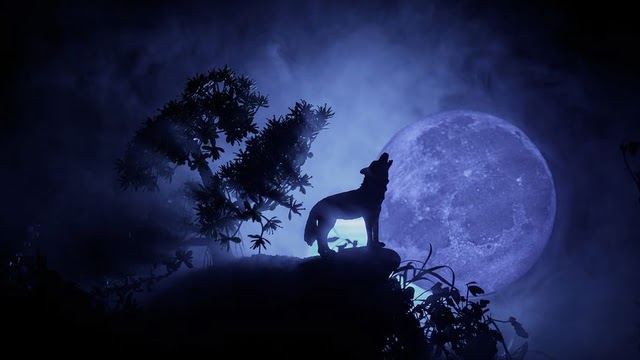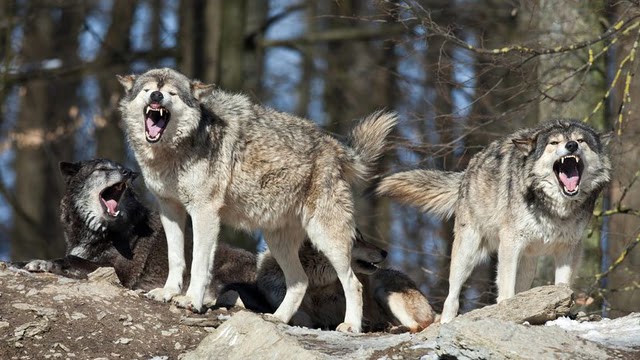Quck answer
Wolves do howl, but not necessarily at the moon. Howling is a form of communication for wolves to communicate with their pack and establish territory. They also howl to locate other pack members and to call for help when they are in danger. The myth of wolves howling at the moon likely came from the fact that they are more active at night, but the moon has no direct influence on their behavior.
Wild Animals

Have you ever wondered why wolves howl at the moon? This belief has been around for centuries and has been depicted in ancient images and literature, as well as in today’s popular culture. However, there is no evidence to support the idea that wolves are howling at the moon. Instead, they howl as a form of long-distance communication, conveying information to other wolves.
Wolves have a natural association with darkness and the moon since they are nocturnal animals. Many ancient civilizations have paired wolves with the moon in their folklore, and even today, some people believe that wolves are howling at the moon. However, experts have found no connection between the phases of the moon and wolf howling.
Why Do Wolves Howl?

Wolves howl for the same reasons humans raise their voices: to be heard. They use howling as a form of long-distance communication, conveying information to other wolves. When they raise their muzzles towards the sky and release their howls, it’s not because they are howling at the moon. Instead, it’s all about acoustics, as projecting their calls upward allows the sound to carry farther. Wolf howls can carry as far as 6 miles in the forest and even 10 miles across the treeless tundra.
Wolves also use other forms of vocalizations to communicate, including barking, growling, and whimpering. Barks can have various meanings, from warning nearby pack members of an incoming predator to calling another wolf into a challenge. Lower-pitched growls signal dominance or an impending confrontation, while high-pitched whimpers indicate submission or friendly greetings.
So, while the connection between wolves and the moon is a popular belief, it is not based on any evidence. Wolves howl for the same reasons humans raise their voices: to be heard.
Wolves use their howls for a variety of reasons, including rallying the pack, signaling their location, and warning outside wolves to stay away. Howling is more frequent during the evening and early dawn, as well as during the wintertime breeding season. Howls also bear information about a wolf’s size and health, which can be used to attract mates. Wolves often howl together in chorus, which can protect the pack by tricking listeners into thinking there are more wolves present. Alpha wolves tend to howl more frequently than those with lower social standing, and pups learn to howl by mimicking adults. Lone wolves may not howl as much to avoid revealing their location to predators. Overall, wolves have an extensive vocabulary to communicate with each other.
FAQs about Wolf Howling
Is it true that wolves howl at the moon?
No, this is just a myth. Wolves howl at night to communicate, and the moon is often visible during those hours.
Do wolves come out more during full moons?
No, wolves are nocturnal animals and are active at night regardless of the phase of the moon.
What sounds do wolves make at night?
Wolves make four types of vocalizations: barking, whimpering, growling, and howling. They make these sounds both day and night.
What is the purpose of wolf howling?
Wolves howl to communicate with other pack members, to mark territory, and to locate prey. It also serves as a way to show affection towards other members of the pack.
Do wolves use howling to communicate with each other?
Yes, howling is a key way for wolves to communicate with each other. They use it to alert pack members about predators and to signal the location of prey.
Learn More About Wolves
Related Articles
- No Need to Howl When You See January’s Wolf Moon
- What Is a Wolf Pack Mentality?
- Gray Wolves Will Get Federal Protection Again in Much of U.S.
- Wolves Are Probably Smarter Than Our Dogs
- What Is a Lone Wolf?
More Great Links
- PBS Nova — Wild Wolves
- International Wolf Center
Sources
- Busch, Robert A. “The Wolf Almanac: A Celebration of Wolves and Their World.” Globe Pequot. 2007.
- Cashford, Jules. “The Moon: Myth and Image.” Thunder’s Mouth Press. 2003.
- Encyclopedia Brittanica. “Why Do Wolves Howl?”
- Feldhamer, George A.; Thompson, Bruce Carlyle and Chapman, Joseph A. “Wild Mammals of North America: Biology, Management and Conservation.” JHU Press. 2003.
- Harrington, Fred H. “What’s in a Howl?” PBS Nova. Updated November 2000.
- Henes, Donna. “The Moon Watcher’s Companion.” Marlowe & Company. 2004.
- International Wolf Center. “How Do Wolves Say Hello?”
- Lopez, Barry Holstun and Bauguess, John. “Of Wolves and Men.” Simon and Schuster. 2004.
- McGough, Will. “Are Wolves Really Howling at the Moon?” July 8, 2013.
- Rosenberg, Donna. “World Mythology: An Anthology of the Great Myths and Epics.” McGraw-Hill Professional. 1994.
- Smithsonian. “Why Do Wolves Howl? And Other Top Wolf Questions Answered” March 22, 2018.
How Do Wolves Say Hello?
FAQ
1. Do wolves really howl at the moon?
Contrary to popular belief, wolves don’t actually howl at the moon. However, they do howl at night, which is often when the moon is visible. Wolves howl for various reasons, including to communicate with other pack members, mark their territory, and attract a mate.
2. Why do wolves howl?
Wolves howl to communicate with each other. They have a complex system of vocalizations that allows them to convey various messages, such as warning others of danger, calling for help, and finding their way back to the pack. Howling also helps keep the pack together and strengthens their social bonds.
3. Are wolves nocturnal?
Yes, wolves are primarily active at night, which is why they are often associated with the moon. However, they can also be active during the day, especially in areas with less human activity.
4. Do wolves only howl at night?
No, wolves can howl at any time of day. However, they are more likely to howl at night when they are most active and when there is less background noise to compete with their vocalizations.
5. Can wolves see in the dark?
Wolves have excellent night vision, which allows them to hunt and navigate in low-light conditions. Their eyes are specially adapted to pick up even the slightest movements in the dark.
6. Do wolves only howl when they are in a pack?
No, wolves can howl both alone and in a pack. However, howling is more common among pack members as it helps them stay in contact with each other and coordinate their movements.
7. How far can a wolf’s howl travel?
A wolf’s howl can travel up to six miles in open terrain, and even further in areas with less background noise. This makes howling an effective way for wolves to communicate across long distances.
8. Are wolves dangerous to humans?
While wolves are generally not a threat to humans, they are wild animals and should be treated with caution. In rare cases, wolves have attacked humans, usually when they feel threatened or cornered. It’s important to give wolves plenty of space and avoid approaching them in the wild.
9. Can you keep a wolf as a pet?
No, it is not safe or legal to keep a wolf as a pet. Wolves are wild animals and have not been domesticated like dogs. They require specialized care and can be dangerous to people and other animals if not properly trained and socialized.
10. Are wolves endangered?
Several subspecies of wolves are currently listed as endangered or threatened, including the Mexican gray wolf, red wolf, and Ethiopian wolf. However, other subspecies, such as the gray wolf, have rebounded in some areas and are no longer considered endangered.
11. What can be done to help protect wolves?
There are several ways to help protect wolves, including supporting conservation organizations, advocating for wolf-friendly policies, and reducing human-wildlife conflict by keeping pets and livestock secure and avoiding areas where wolves are known to live. It’s also important to educate others about the important role wolves play in their ecosystems and dispel common myths and misconceptions about these magnificent animals.





Leave a Reply